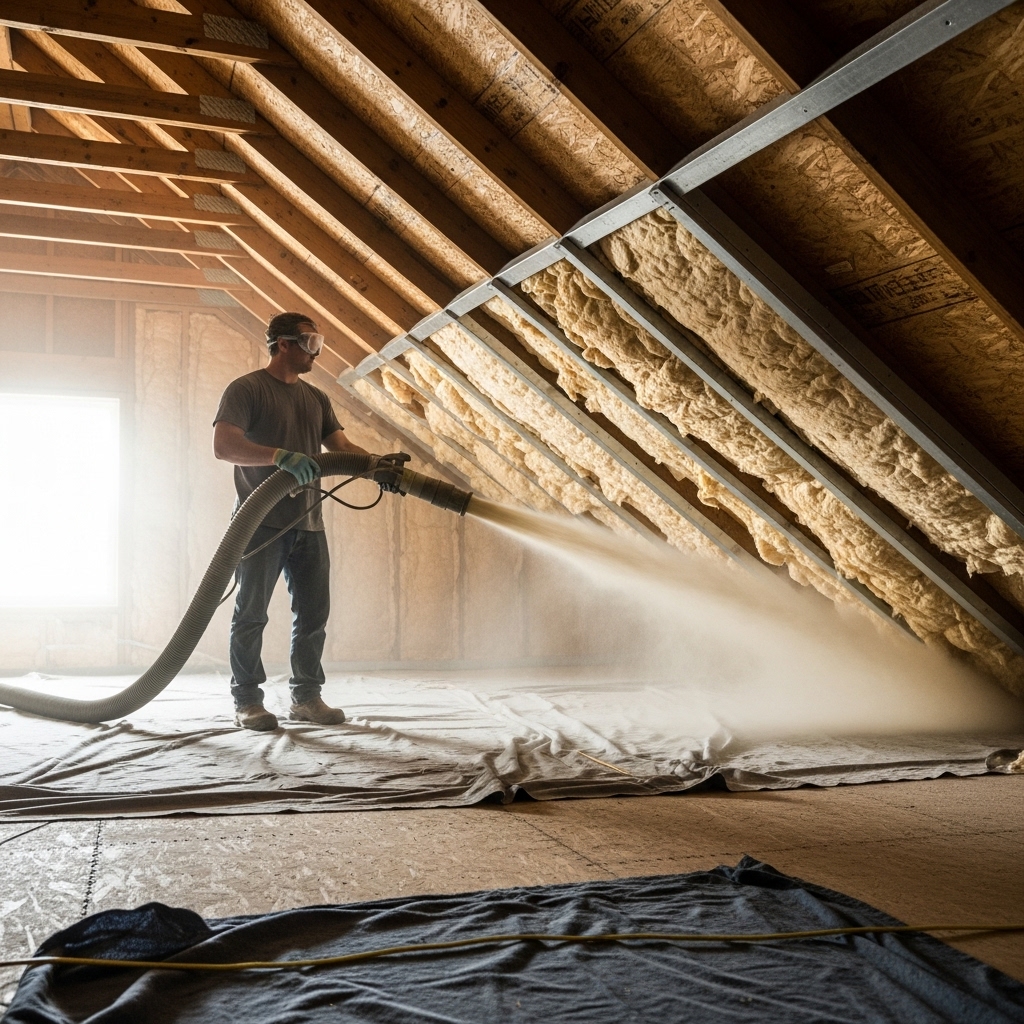Blown-in insulation is the quiet hero of many Los Angeles comfort makeovers. It slips into attics and walls without fanfare, fills gaps traditional materials miss, and turns irregular spaces into a smooth, continuous blanket. For homes stretched across our coastal neighborhoods, inland valleys, and hillside enclaves, that flexibility is the key to an upgrade that feels natural rather than forced. If you are early in your planning and want to visualize each step from prep to final walkthrough, reviewing local best practices for insulation installation is a helpful first move.
Why Blown-In Makes Sense in Los Angeles
From Spanish Revival bungalows to postwar ranches and modern infill townhomes, Los Angeles housing is wonderfully varied. Attics can be open and inviting or tight and cross-braced with low clearances. Walls may be plaster over lath, drywall over irregular studs, or a mix from different eras. Blown-in insulation adapts to all of this, packing gently into voids and rounding over the peaks and valleys of framing so thermal performance becomes continuous rather than spotty.
In attics, blown-in materials like fiberglass and cellulose ride above joists to a consistent depth and flow around obstacles that would otherwise invite gaps. In walls, dense-pack techniques allow material to fill cavities through small access points, preserving finishes while upgrading comfort. Across Los Angeles microclimates, the result is a home that shrugs off late-afternoon heat and keeps early mornings cozy without constant fiddling with the thermostat.
Material Choices: Fiberglass and Cellulose
Both fiberglass and cellulose have strong track records when installed thoughtfully. Fiberglass tends to be light and resilient, maintaining loft well. Cellulose offers excellent coverage and acoustic benefits, which can be a welcome bonus near busy streets or flight paths. The best choice depends on your home’s structure, your goals for sound and thermal performance, and whether you are topping an attic, filling walls, or both.
In some projects, a hybrid approach is used. For example, a home might receive dense-pack cellulose in the walls for sound control and blown-in fiberglass in the attic for stable loft and easy future access. The theme is not loyalty to a label but respect for the assembly and the outcomes you value.
Preparation: The Step That Unlocks Performance
Before a single bag is opened, the attic or wall assembly should be prepared to welcome new material. In attics, that means sealing plumbing and electrical penetrations, capping chaseways, and framing protective dams around hatches, can lights, and chimneys where required. Baffles at the eaves maintain airflow and protect the roof deck. In walls, prep involves mapping utilities, planning access points, and protecting interiors so the work is clean and predictable.
This preparation phase is where small problems are discovered and solved, preventing them from becoming long-term annoyances. A bath fan that vents into the attic is rerouted outdoors. A disconnected duct is repaired before it continues to dump conditioned air into unconditioned space. By resolving these issues, the new insulation can do its job without competing against hidden leaks and shortcuts from decades past.
Installation in Open Attics
In open attics, crews stage hoses, set up containment, and work from the farthest corners back toward the hatch to ensure even coverage. They build up to a uniform depth, check edges where wind-washing could reduce performance, and verify that baffles keep airflow clear at the eaves. Platforms to mechanical equipment are preserved, and dams keep insulation from spilling into pathways and hatches.
Good crews document the process with photos, especially around tricky areas like skylight wells and transitions. That record lets you see the work in places you won’t frequently visit and gives future trades a map of what lies beneath the surface.
Dense-Pack Methods for Walls
Dense-pack installation requires a practiced hand. Technicians drill small access points at strategic locations, insert hoses, and fill each cavity to the target density so the material knits together and resists settling. They watch for telltale back pressure that signals a full cavity and move methodically to cover the entire wall. Afterward, access points are patched to match the surrounding finish as closely as possible.
This technique shines in older Los Angeles homes where walls were never insulated. The transformation is immediately noticeable in rooms that once felt drafty or overly warm on sunny afternoons. Paired with careful air sealing at outlets and trim, the walls become calm, steady surfaces instead of radiators for outdoor conditions.
Ventilation and Moisture Behavior
Even in our dry climate, assemblies handle moisture every day as temperatures rise and fall. Bath fans must vent outdoors, and roofs should be detailed to allow airflow at the eaves if you keep a vented attic. Baffles protect that airflow from being choked by insulation. In walls, properly flashed openings and intact weather barriers keep water out and let incidental moisture dry. The goal is balance—a home that holds comfort without trapping humidity where it doesn’t belong.
Neighborhoods near the coast see morning marine layers more often, while inland valleys swing between cool nights and hot afternoons. Designing with these rhythms in mind ensures that your insulation remains stable and effective through seasons and across microclimates.
Working Around Lights, Ducts, and Special Features
Attics and walls are full of details that deserve attention. Recessed lights must be evaluated for their rating before being surrounded. Ducts benefit from sealing and protection even as insulation wraps the spaces around them. Chimneys and flues require proper clearances and framing. Skylight wells need thoughtful coverage to avoid hot spots that transmit heat into the room below. Each of these steps safeguards performance and safety.
Architectural features like exposed rafters or decorative ceilings may call for customized approaches. A professional crew will propose solutions that preserve the look while improving the home’s overall comfort, often by focusing on adjacent surfaces or by enhancing the roof assembly above.
Comfort, Acoustics, and Everyday Life
Blown-in insulation’s biggest compliment is how quickly it becomes invisible to your routine. The upstairs that used to overheat in late afternoon begins to feel normal. Early mornings lose their chill. Street noise softens into a background murmur. The thermostat becomes less of a daily focus because rooms hold their temperature with less help from the mechanical system.
These quiet improvements accumulate day after day, which is why homeowners often say the house simply feels better. When insulation partners with air sealing and ventilation, the result is a home that requires less effort to keep comfortable, regardless of neighborhood or season.
Project Timing, Access, and Cleanliness
Most blown-in projects are designed to minimize disruption. Crews protect access routes, stage materials thoughtfully, and maintain a clean workspace. If removal is part of the plan, it is contained and completed before new material arrives. Daily communication helps you understand which areas will be affected and when, so you can plan around the work without surprises.
Good documentation, including before-and-after photos and notes on hidden details, offers confidence that the installation meets the plan. A final walkthrough confirms coverage and addresses any questions about maintenance or future work in the same spaces.
Neighborhood Patterns and Microclimate Notes
Across Los Angeles, each neighborhood has a rhythm. Coastal homes feel the cool push of evening breezes and the damp hush of morning fog. Inland homes ride larger temperature swings. Hillside properties contend with wind and sun exposure that can shift over a single day. Blown-in insulation meets these patterns by creating a continuous barrier against heat flow and by reducing the pathways that carry outdoor air through your home’s skeleton.
When you plan with these patterns in mind, the improvement feels natural. You are not fighting the house or the climate; you are aligning your home’s envelope with how Los Angeles actually behaves.
Frequently Asked Questions
Will blown-in insulation work with my older plaster walls?
Yes, dense-pack methods are designed for older homes with plaster and lath. Access points are carefully planned and patched, and the material fills cavities without removing large sections of finish. A test section can confirm how your walls respond before the full installation proceeds.
Is fiberglass or cellulose better for my home?
Both perform well when installed correctly. Fiberglass maintains loft and resists settling, while cellulose offers excellent coverage and sound-dampening characteristics. The best choice depends on your goals for sound control, the assembly type, and how the material will interact with ventilation and moisture management.
Do I need to remove my old attic insulation first?
Not always. If the existing material is clean and dry, topping it can be effective. If there is contamination, moisture, or significant unevenness, removal and remediation produce a cleaner, more predictable base for new material. An inspection will guide the decision.
Will the process be messy?
Professional crews use containment, protect access routes, and clean thoroughly. In walls, dust control measures keep living spaces tidy, and access points are patched promptly. The aim is an efficient, respectful process with minimal disruption.
How does blown-in insulation affect ventilation?
In attics, baffles preserve airflow at the eaves so ventilation continues to protect the roof deck. The insulation is installed to avoid blocking these pathways. In walls, ventilation is not part of the assembly; instead, the focus is on keeping exterior weather barriers intact and allowing assemblies to dry as designed.
Can blown-in insulation help with noise?
Yes. By filling voids and reducing air pathways, blown-in materials soften sound transmission. Many homeowners notice that rooms near busy streets or above garages feel calmer after the upgrade.
If you are ready to make your Los Angeles home calmer, cooler, and easier to live in, partner with a crew that treats preparation and documentation as part of the craft. To see how the process unfolds step by step and to plan your project with confidence, start by exploring expert insulation installation resources and then schedule a visit. The right plan delivers comfort that blends seamlessly into everyday life.

